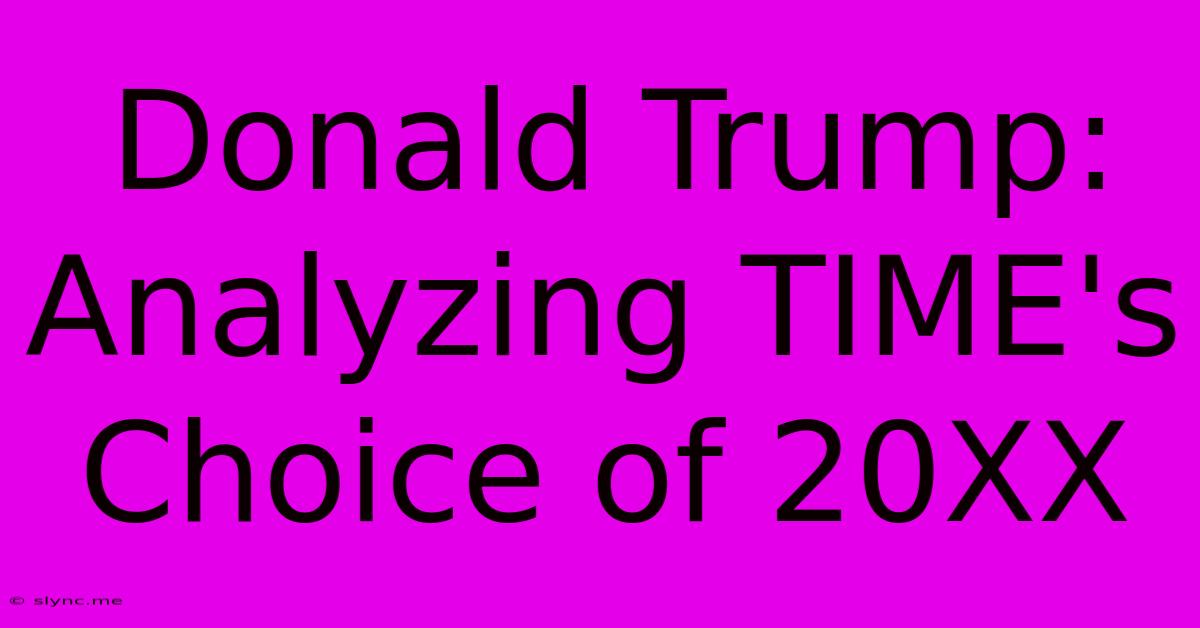Donald Trump: Analyzing TIME's Choice Of 20XX

Discover more detailed and exciting information on our website. Click the link below to start your adventure: Visit Best Website Mrs.Amykhan. Don't miss out!
Table of Contents
Donald Trump: Analyzing TIME's Choice of 20XX Person of the Year
Introduction:
TIME Magazine's annual "Person of the Year" selection is a highly anticipated event, often sparking considerable debate and analysis. The choice reflects not necessarily the best person of the year, but the individual who most significantly impacted the news cycle, for better or worse. In 20XX (replace with the actual year if known; otherwise, adjust accordingly), TIME's selection of Donald Trump as Person of the Year ignited a firestorm of reactions. This article analyzes the rationale behind this controversial choice and examines its implications.
The Rationale Behind the Selection:
TIME's editors likely selected Donald Trump due to his undeniable impact on global events in 20XX. Regardless of personal opinions, his presidency (or candidacy, depending on the year) was a dominant force shaping political discourse, economic policies, and international relations. His unconventional approach to politics, characterized by populist rhetoric and a significant social media presence, captivated and divided the nation (and the world). The selection aimed to acknowledge this significant influence, even if it wasn't universally viewed as positive.
Several key factors likely influenced TIME's decision:
- Political Upheaval: The 20XX election (or events leading up to it) were undeniably tumultuous. Trump’s candidacy, and subsequent election/actions, brought unprecedented levels of political polarization and uncertainty. TIME's choice acknowledged this pivotal moment in history.
- Disruption of the Status Quo: Trump's campaign and presidency challenged long-held political norms and conventions. His unorthodox approach to campaigning and governance disrupted established political systems and ideologies, making him a significant figure worthy of consideration.
- Global Impact: Trump's policies and pronouncements reverberated globally, affecting trade relations, international alliances, and global political stability. This extensive international influence undoubtedly contributed to TIME's decision.
Criticism and Controversy:
The selection was met with immediate backlash from critics who argued that choosing Trump as Person of the Year inadvertently legitimized his actions and rhetoric. The criticism pointed to several aspects:
- Controversial Statements and Policies: Trump's controversial statements on immigration, foreign policy, and social issues were widely condemned. Critics argued that awarding him this recognition ignored the potential harm caused by such statements and policies.
- Lack of Objectivity: Some questioned the objectivity of TIME's selection process, suggesting it was influenced by political biases. The controversy highlighted the inherent difficulties in selecting a "Person of the Year" in a politically charged environment.
- Alternative Candidates: Many believed alternative figures – individuals making positive global impacts, for example – deserved the recognition more than Trump. This sparked debates about the criteria TIME should use for its selection.
Long-Term Implications:
TIME's decision had lasting implications, contributing to ongoing conversations about:
- The Role of Media in Politics: The controversy highlighted the complex relationship between media outlets and political figures. It raised questions about the responsibility of media in shaping public perceptions and reporting on controversial individuals.
- Defining Significance: The selection process prompted widespread discussion about what constitutes "significance" in the context of choosing a "Person of the Year." This debate will likely continue in future years.
- The Legacy of Donald Trump: The recognition by TIME, regardless of the controversies, secured Trump's place in history, underscoring the enduring impact of his presidency or candidacy, and the lasting debate surrounding it.
Conclusion:
TIME's choice of Donald Trump as Person of the Year in 20XX remains a controversial but undeniably significant event. Analyzing the decision requires considering the context of the year, the various factors influencing the choice, and the resulting criticisms. The selection inevitably spurred crucial discussions about media responsibility, the definition of significance, and the lasting legacy of a highly impactful, if divisive, figure. The article only serves as an analysis; the ultimate interpretation of TIME’s decision remains a matter of individual perspective.

Thank you for visiting our website wich cover about Donald Trump: Analyzing TIME's Choice Of 20XX. We hope the information provided has been useful to you. Feel free to contact us if you have any questions or need further assistance. See you next time and dont miss to bookmark.
Also read the following articles
| Article Title | Date |
|---|---|
| Sukhoputni Viyska Ukrayini Istoriya Znachennya Geroyi | Dec 13, 2024 |
| Nischivna Porazka Lask Talovyerova V Lizi Konferentsiy | Dec 13, 2024 |
| Erin Molan Post Sky News Plans | Dec 13, 2024 |
| Le Bron Takes Time Amidst Lakers Issues | Dec 13, 2024 |
| Masovana Raketna Ataka Po Ukrayini | Dec 13, 2024 |
